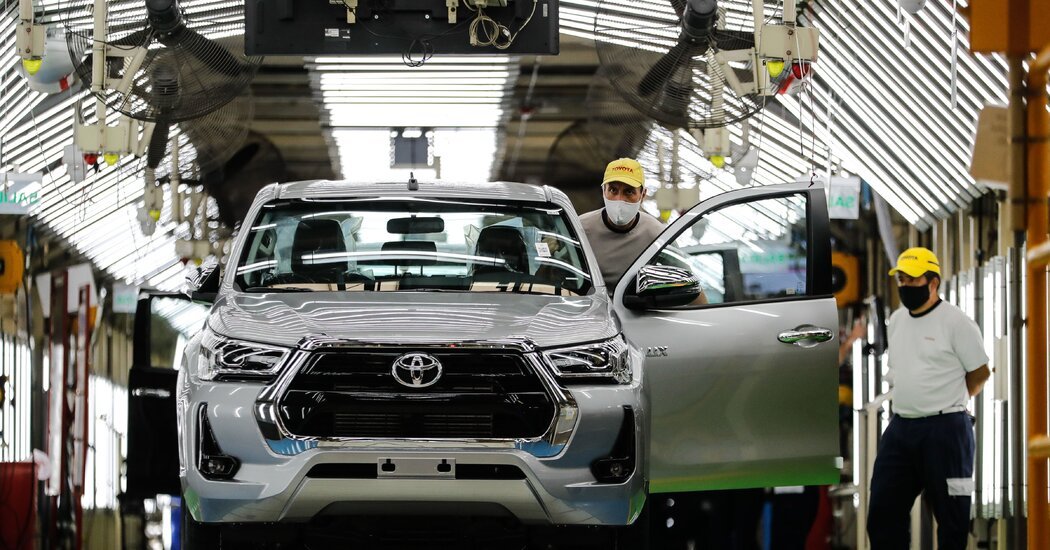Toyota Topped G.M. in U.S. Car Sales in 2021 – The New York Times
Advertisement
Supported by
After struggling to produce cars because of a global computer chip shortage, automakers are trying to move quickly to making electric vehicles.
Send any friend a story
As a subscriber, you have 10 gift articles to give each month. Anyone can read what you share.
By Neal E. Boudette
Toyota Motor unseated General Motors as the top-selling automaker in the United States last year, becoming the first manufacturer based outside the country to achieve that feat in the industry’s nearly 120-year history.
That milestone underlines the changes shaking automakers, which face strong competition and external forces as they move into electric vehicles. And it came in a tumultuous and strange year in which automakers contended with an accelerating shift to electric vehicles and struggled with profound manufacturing challenges. New car sales have been damped by a severe shortage of computer chips that forced automakers to idle plants even though demand for cars has been incredibly robust.
G.M., Ford Motor and Stellantis, the automaker created by the merger of Fiat Chrysler and Peugeot, produced and sold fewer cars than they had hoped to in 2021 because they were hit hard by the chip shortage. Toyota was not hurt as much.
In addition to that shortage, the coronavirus pandemic and related supply-chain problems depressed sales while driving up the prices of new and used cars, sometimes to dizzying heights. Auto manufacturers sold just under 15 million new vehicles in 2021, according to estimates by Cox Automotive, which tracks the industry. That is 2.5 percent more than in 2020 but well short of the 17 million vehicles the industry usually sold in a year before the pandemic took hold.
G.M. said on Tuesday that its U.S. sales slumped 13 percent in 2021, to 2.2 million trucks and cars. Toyota had access to more chips because it set aside larger stockpiles of parts after an earthquake and tsunami in Japan knocked out production of several key components in 2011. Its 2021 sales rose more than 10 percent, to 2.3 million.
“The dominance of the U.S. automakers of the U.S. market is just over,” said Erik Gordon, a business professor at the University of Michigan who follows the auto industry. “Toyota might not beat G.M. again this year, but the fact that they did it is symbolic of how the industry changed. No U.S. automaker can think of themselves as entitled to market share just because they’re American.”
Ford is expected to finish third when the company releases sales data on Wednesday.
The shortage of chips stems from the beginning of the pandemic, when auto plants around the world closed to prevent the spread of the coronavirus. At the same time, sales of computers and other consumer electronics took off. When automakers resumed production, they found fewer chips available to them.
Despite weak new-vehicle sales, automakers and dealers alike have been ringing up hefty profits because they have been able to raise prices.
“Sales volumes are down but our margins are up and expenses are down,” said Rick Ricart, whose family owns Ford, Hyundai, Kia and other dealerships around Columbus, Ohio. “We barely had any inventory cost now. Cars arrive on the truck and they’re already sold. They’re gone within 24 to 48 hours.”
Automakers are also contending with the transition to electric cars and trucks. Many companies are spending tens of billions of dollars designing battery-powered models and building plants to produce them. They are racing to catch up to Tesla, which sells a large majority of electric vehicles now.
But most established automakers are unlikely to gain ground in U.S. electric vehicle sales this year because they are not in a position to produce many tens of thousands of such cars for at least another year or two.
And Tesla, which was founded in 2003, is not standing still. After reporting a nearly 90 percent jump in global sales last year, to just shy of one million, the company plans to start mass production at two new factories this year, near Austin, Texas, and Berlin. It has been less affected by the chip shortage because it was able to switch to types of chips that are more readily available.
The electric-car maker does not break out sales by country, but Cox Automotive estimated that it sold more than 330,000 in the United States, or roughly as many vehicles as Mercedes-Benz and BMW each sold here.
Ford is perhaps the only major automaker that could pose a serious competitive threat to Tesla this year. This spring, Ford plans to start selling an electric version of its F-150 pickup truck, the top-selling vehicle in the United States. The company has taken more than 200,000 reservations for that truck, the F-150 Lightning, and hopes to produce more than 50,000 this year. It is increasing production at a plant near Detroit to build 80,000 in 2023 and up to 150,000 in 2024.
“The F-150 is the most important franchise in our company,” Kumar Galhotra, president of Ford’s Americas and international markets group, said in an interview. “The F-150 Lightning shows how serious our commitment is to the E.V. market.”
Ford has been selling a popular electric sport-utility vehicle, the Mustang Mach E, for nearly a year. It said Tuesday that it aimed to increase production of the Mach E to 200,000 vehicles a year by 2023.
Other automakers are planning to produce relatively modest numbers of electric cars this year because they and their suppliers are still gearing up to build factories and produce batteries and other components. G.M. has set a goal of producing only electric vehicles by 2035, and on Wednesday it will unveil a battery-powered Chevrolet Silverado pickup truck at the Consumer Electronics Show. But the electric Silverado isn’t expected to go into production until 2023.
The global surge. The coronavirus is spreading faster than ever at the start of 2022, but the last days of 2021 brought the encouraging news that the Omicron variant produces less severe illness than earlier waves. As such, governments are focusing more on expanding vaccination than limiting the spread.
I.C.U.s and Hospitals. Covid hospitalizations in the U.S. are surging, but a smaller proportion of patients in Omicron hot spots are landing in intensive care units or requiring mechanical ventilation. Use our tracker to see how I.C.U.s in your area have been affected.
School disruptions. The post-holiday Covid surge has caused some U.S. school districts to postpone reopening or switch to remote instruction. Chicago canceled classes entirely for a day as teachers resisted returning to school. But other large school systems, including New York City, have stayed open.
Return to office. For many businesses, the recent surge has brought a swift reversal of return-to-office plans. In recent days, companies including Goldman Sachs and Chevron have begun to backtrack on workplace policies. Some are telling employees to stay home with just days, or even hours, to spare before their planned returns.
Staying safe. Worried about spreading Covid? Keep yourself and others safe by following some basic guidance on when to test and how to use at-home virus tests (if you can find them). Here is what to do if you test positive for the coronavirus.
G.M. has also had to suspend production of its main electric vehicle, the Chevrolet Bolt, because of a manufacturing defect that can cause its battery to catch fire. In the last three months of the year, the company sold just 25 Bolts.
The U.S. auto industry has long been defined by G.M., which has held the top spot on annual sales rankings for nearly a century after it sped past Ford in the late 1920s and early ’30s.
Toyota started selling cars in the United States in 1965. It began production at its first U.S. plant in Georgetown, Ky., in 1988, building a reputation for quality as G.M., Ford and Chrysler struggled. Its growth also raised trade tensions between the United States and Japan and gave rise to popular fears that Japanese businesses would decimate American companies.
Toyota then expanded into luxury cars with its Lexus brand, and added the Toyota Tundra full-size pickup truck to compete in a segment dominated by the manufacturers based in and around Detroit. By the beginning of this century, the Toyota Camry was often the top-selling car in the country, and the Japanese automaker soon passed Chrysler and Ford in annual sales.
Its image was further enhanced when it introduced the Prius hybrid as gasoline prices were rising and consumers were focusing more on fuel economy. The company still dominates sales of hybrid vehicles, which couple gasoline engines with batteries and electric motors.
But Toyota has been slower to embrace fully electric vehicles, which could undercut its growth in the coming years. At an event last month, the company’s president, Akio Toyoda, stood in front a row of prototype E.V.s and outlined a plan to significantly ramp up production of such cars by 2030.
But Toyota is also now contending with supply chain problems. In recent months, the company has had to sharply slow production around the world as it has exhausted its chip stockpile and had to wait for its suppliers to make more.
Advertisement




